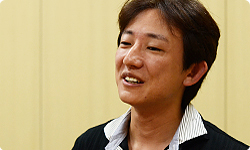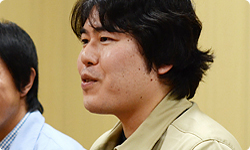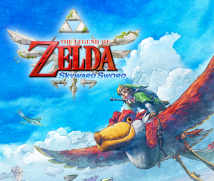4. Playing Tag on Familiar Grounds
The more I ask about The Legend of Zelda: Skyward Sword, the more the sense of its denseness takes on meaning. Why do you think such an incredible feeling of density arose, Ito-san?
Hmm...
Was it the large scale of production? Or the long development period?
(laughs)
Or was that just the way you made it?
I think that feeling of density is connected to how you go to the same game field multiple times, but it feels fresh each time. In the series so far, you went to a dungeon once, and that was the end.
That’s right. No matter how big and complicated it was, if you beat the boss deep inside, you never went there a second time.
Uh-huh. But in this game, once you get through a dungeon, you may have occasion to visit it again. You may think that the second time will be easy because you’ve already beaten it, but there may be new challenges. In that way, you visit the same places over and over, but it’s made to continue being enjoyable. What’s more, there are plenty of rewards here and there, which I think gives rise to that feeling of density. For example, there’s a new element of play called the Silent Realm.
Oh, that’s right. Fujibayashi-san, could you explain about the Silent Realm?
Sure. You can use Dash this time, so...
That came up in the last session as well. It’s an action that arose when the A Button opened up.
That’s right. You can do things like scramble up cliffs and spring across divides and hang there. Link has a lot of actions this time. We wondered if we could make some kind of new gameplay involving that Dash and came up with a game similar to tag.

Is it ok to assume that the Silent Realm is sort of a game of tag?
Yes. So that’s why you can’t use items like the sword and shield there.
Link is an unarmed hero.
That’s right. The goal of this game is to collect Sacred Tears here and there around the game field . But if enemies find you, the world changes and Link has to run for his life. Link is unarmed, so he can’t fight enemies. If he gets hit, that’s the end.
That is like tag. And Dash comes into play.
Yes. I wanted to make something that switched back and forth in real time between still and active, like “I won’t let enemies find me,” and “Now that they’ve found me, I won’t let them catch me” . Once you get a Sacred Tear, a period of safe time begins, so you think about the order you will get that Sacred Tear in, or, in the worst case, you plan for when an enemy will find you and purposely leave a Sacred Tear that’s easy to get. There’s a strategic element. You can say the same thing with the game of tag in real life, but those that know the landscape better have an advantage.
I see, that’s why it’s so important to use fields the player has been to before.
That’s right. The player has already been there, so he or she thinks, “If an enemy chases me, I’ll run that way,” or “I can Dash up this slope.”
It’s a familiar place, so it’s easy to play.
That’s right. And as you come and go during the course of the main adventure, some places give you a sense like “I bet something is up on that conspicuous rock shelf.”
Then when you play the Silent Realm and check that place out, you’re like, “I knew it! There’s a Sacred Tear here! (laughs) Then you’re really happy.
And that may make you want to remember the terrain more. By playing the Silent Realm, the grounds you’re playing in become familiar. (laughs)
Your degree of familiarity increases.
That’s right. And to return to the theme of density, we blurred the transition between dungeons and fields.

How so?
In the Legend of Zelda series up until now, the fields were the scene of more easy-going gameplay, but once you went into a dungeon, you would get a new item and play strategically to solve puzzles. There was a clear division. But this time, you may get a new item in the game field and the search expands from there.
You can even enjoy solving puzzles in the fields.
That’s right. I think that, too, is connected to the game’s density.
There isn’t a clear borderline between fields and dungeons as in past Legend of Zelda games. Why did you try to blur the lines there?
Until now, when you went into a dungeon, for example, you learned how to use a new item. Then you were asked, “Can you solve this?” and had to solve a puzzle. In other words, a process of question-and-answer commenced. We call it the Zelda etiquette among ourselves.
Yes.
And since there are so many new aspects to the items this time, it would get very hectic if the player had to find the item, learn how to use it and solve the puzzle or fight against the boss all within the same dungeon.
The gameplay gets hectic.
Yes. Therefore, if you get the Slingshot in a game field like the forest, you'll be able to use it in the dungeon ahead after you learnt how to use it in the field.
I see.
Now, I just mentioned that there isn't a clear separation between fields and dungeons. However, we paid a lot of attention to how to enter dungeons. I wanted to keep the sound from the original Legend of Zelda game, where Link went into a dungeon with a tomp-tomp-tomp sound .
Yes.
I really wanted to recreate that! (laughs)
(laughs)
Of course, I couldn’t recreate it exactly as on the Family Computer Disk System, but I do think we achieved a similar effect. The staff who made that will participate in a later session of “Iwata Asks,” so they can talk about that then. (Editor’s note: In the Family Computer Disk System version of The Legend of Zelda that was available in Japan, the hardware made a distinctive mechanical sound when the system reloaded data every time Link entered a dungeon.)
Yes. (laughs)
